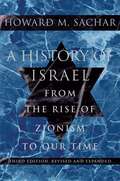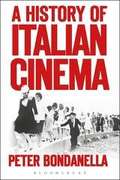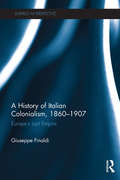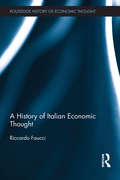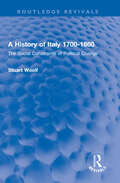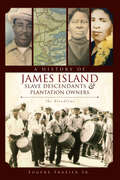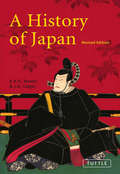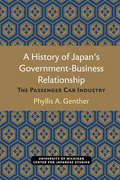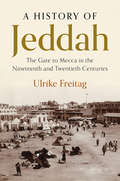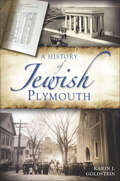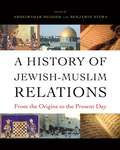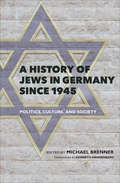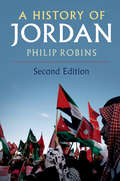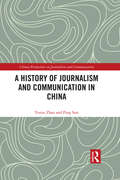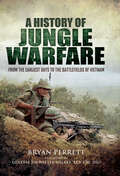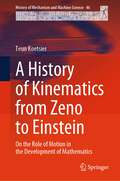- Table View
- List View
A History of Israel: From the Rise of Zionism to Our Time
by Howard M. SacharFirst published in 1976, Howard M. Sachar's A History of Israel: From the Rise of Zionism to Our Time was regarded one of the most valuable works available detailing the history of this still relatively young country. More than 30 years later, readers can again be immersed in this monumental work. The second edition of this volume covers topics such as the first of the Aliyahs in the 1880s; the rise of Jewish nationalism; the beginning of the political Zionist movement and, later, how the movement changed after Theodor Herzl; the Balfour Declaration; the factors that led to the Arab-Jewish confrontation; Palestine and its role both during the Second World War and after; the war of independence and the many wars that followed it over the next few decades; and the development of the Israeli republic and the many challenges it faced, both domestic and foreign, and still faces today.This is a truly enriching and exhaustive history of a nation that holds claim to one of the most complicated and controversial histories in the world.
A History of Italian Cinema
by Peter BondanellaAn unprecedented survey of Italian film from the leading expert in the field <P><P>A History of Italian Cinema is a major new study from the author of the bestselling Italian Cinema - which has been published in three landmark editions and celebrated its twenty-fifth anniversary in 2008. Building upon his decades of research, Peter Bondanella has now written the definitive history of the subject, from the birth of cinema to the present day. He has rethought, reorganized, and completely rewritten his previous work, which focused on postwar cinema, and has broadened his coverage of the spaghetti western and comedy genres. Bondanella also now covers a huge range of work that was not previously considered, particularly both popular and 'B' genres, including: the sword and sandal epic or "peplum" film of the 1950s; the Italian horror film, the so-called spaghetti nightmare films (including the subcategories of horror, the Italian zombie and cannibal films), that began in the 1950s and continue through the present; the giallo or Italian mystery thriller; and the poliziesco or Italian crime film from the 1970s to the present. This new book also examines the emergence of a "third wave" of new auteurs born in the 1950s as well as an even younger group of important directors born in the 1960s who have already made their mark on the direction of the Italian cinema in the third millennium.
A History of Italian Colonialism, 1860–1907: Europe’s Last Empire (Empires in Perspective)
by Giuseppe FinaldiThis book provides a narrative history of Italian colonialism from Italian unification in the 1860s to the first decade of the twentieth century; that is, it details Italy’s imperialism in the years of the Scramble for Africa. It deals with the factors that drove Italy to search for territory in Africa in the 1870s and 1880s and describes the reasoning behind the trajectories adopted and objectives pursued. The events that brought Italy to open conflict with the Ethiopian Empire culminating in the Italian defeat at Adowa in March 1896 are central to the book. However its scope is much broader, as it considers the establishment of Italian power in Eritrea as well as Somalia before and after the defeat. By telling its history, it explains why Italy emerged irresolute and humiliated in this, its first thrust into Africa, yet nonetheless determined to pursue expansion in the future. The seeds for the conquest of Libya in 1911 and Ethiopia in 1935 had been sown.
A History of Italian Economic Thought (The Routledge History of Economic Thought)
by Riccardo FaucciThis book provides the non-Italian scholar with an extensive picture of the development of Italian economics, from the Sixteenth century to the present. The thread of the narrative is the dialectics between economic theory and political action, where the former attempts to enlighten the latter, but at the same time receives from politics the main stimulus to enlarge its field of reflection. This is particularly clear during the Enlightenment. Inside, this book insists on stressing that Galiani, Verri, and Beccaria were economists quite sensitive to practical issues, but who also were willing to attain generally valid conclusions. In this sense, "pure economics" was never performed in Italy. Even Pareto used economics (and sociology) in order to interpret and possibly steer the course of political action. Within this book it illustrates the Restoration period (1815-48). There was a slowdown of the economists' engagement, due to an adverse political situation, that prompted the economists to prefer less dangerous subjects, such as the relationship between economics, morals, and law (the main interpreter of this attitude was Romagnosi). After 1848, however, in parallel with the Risorgimento cultural climate, a new vision of the economists' task was eventually manifested. Between economics and political Liberalism a sort of alliance was established, whose prophet was F. Ferrara. While the Historical school of economics of German origin played a minor role, Pure Economics (1890-1940 approx.) had a considerable success, as regards both economic equilibrium and the theory of public finance. Consequently, the introduction of Keynes's ideas was rather troubled. Instead, Hayek had an immediate success. This book concludes with a chapter devoted to the intense relationships between economic theories, economic programmes and political action after 1945. Here, the Sraffa debate played an important role in stimulating Italian economists to a reflection on the patterns of Italian economy and the possibilities of transforming Italy's economic and social structure.
A History of Italian Wine: Culture, Economics, and Environment in the Nineteenth through Twenty-First Centuries
by Paolo Tedeschi Manuel Vaquero Piñeiro Luciano MaffiThis book analyzes the evolution of Italian viticulture and winemaking from the 1860s to the new Millennium. During this period the Italian wine sector experienced a profound modernization, renovating itself and adapting its products to international trends, progressively building the current excellent reputation of Italian wine in the world market.Using unpublished sources and a vast bibliography, authors highlight the main factors favoring this evolution: public institutional support to viticulture; the birth and the growth of Italian wine entrepreneurship; the improvement in quality of the winemaking processes; the increasing relevance of viticulture and winemaking in Italian agricultural production and export; and the emergence of wine as a cultural product.
A History of Italy 1700-1860: The Social Constraints of Political Change (Routledge Revivals)
by Stuart WoolfFirst Published in 1979, A History of Italy 1700-1860 provides a comprehensive overview of Italy’s political history from 1700-1860. Divided in five parts it deals with themes like the re-emergence of Italy; Italy as the ‘pawn’ of European diplomacy; social physiognomy of the Italian states; problems of the government; enlightenment and despotism (1760-90); the offensive against the Church; revolution and moderation (1789-1814); revolution and the break with the past; rationalization and social conservatism; the search for independence (1815-47); legitimacy and conspiracy; alternative paths towards a new Italy; and the cost of independence (1848-61). It fills a major gap and presents a thoughtful and well-integrated political narrative of this complex period in Italy’s development. This book is an essential read for students and scholars of Italian history and European history.
A History of James Island Slave Descendents & Plantation Owners: The Bloodline (American Heritage Ser.)
by Eugene FrazierJames Island remains one of the few places in the United States where descendants of slaves can easily trace their roots to one of the seventeen slave plantations. For many African Americans, it is hard to imagine how far this small island on the coast of South Carolina has come. It has left them with a legacy of the pain of living in a time and place wrought with hardship but somehow still intermingled with the happiness that comes from a community built on family, love, strength and honor. In this powerful collection, local resident and oral historian Eugene Frazier chronicles the stories of various James Island families and their descendants. Frazier has spent years collecting family and archival photographs and family remembrances to accompany the text, while also paying homage to men and women of the United States military and African American pioneers from James Island and surrounding areas.
A History of Japan
by Conrad TotmanThis is an updated edition of Conrad Totman's authoritative history of Japan from c.8000 BC to the present day. The first edition was widely praised for combining sophistication and accessibility. Covers a wide range of subjects, including geology, climate, agriculture, government and politics, culture, literature, media, foreign relations, imperialism, and industrialism. Updated to include an epilogue on Japan today and tomorrow. Now includes more on women in history and more on international relations. Bibliographical listings have been updated and enlarged.
A History of Japan
by Kenneth G. HenshallIn a rare combination of comprehensive coverage and sustained critical focus, this book examines Japanese history in its entirety to identify the factors underlying the nation's progression to superpower. Japan's achievement is explained not merely in economic terms, but at a more fundamental level, as a product of historical patterns of response to circumstance. Japan is shown to be a nation historically impelled by a pragmatic determination to succeed. The book also highlights unresolved questions and little-known facts.
A History of Japan (Routledge Library Editions: Japan)
by Hisho SaitoThis volume presents the Japanese version of the history of Japan from its origins, through the subjection of Korea, the introduction of Chinese culture, rebellion in Korea, Buddhism, Taika reforms, Ainu insurrection, the founding of Kyoto as the capital, the power of Fujiwara, the founding of the Kamakura Shogunate, Hojo family, Ashikaga Shogunate, Oda & Toyotomi families, Tokugawa Shogunate, the beginning of the Meiji, relations with Korea, Russia and the Chino-Japanese war of 1894, ending with the Russo-Japanese war of 1904.
A History of Japan: Revised Edition
by Richard Mason John CaigerA classic of Japanese history, this book is still the preeminent work on the history of Japan. Newly revised and updated, A History of Japan is a fascinating look at the nation of Japan throughout history. Starting in ancient Japan during its early pre-history period A History of Japan covers every important aspect of history and culture through feudal Japan to the post-cold War period and collapse of the Bubble Economy in the early 1990's. Recent findings shed additional light on the origins of Japanese civilization and the birth of Japanese culture. Classic illustrations and unique pictures are dispersed throughout the book.A History of Japan, Revised Edition includes:Archaic Japan-including Yamato, the creation of a unified state, the Nana Period, and the Heian periodMedieval Japan- including rule by the military houses, the failure of Ashikaga Rule, Buddhism, and the Kamakura and Muroachi Periods periodsEaly Modern Japan-including Japanese feudalism, administration under the Tokugawa, and society and culture in early modern JapanModern Japan-including The Meiji Era and policies for modernization, from consensus to crisis (1912-1937), and solutions through forceThis contemporary classic continues to be a central book in Japanese studies.
A History of Japanese Mathematics (Dover Books on Mathematics)
by David E. Smith Yoshio MikamiOne of the first books to show Westerners the nature of Japanese mathematics, this survey highlights the leading features in the development of the wasan, the Japanese system of mathematics. Topics include the use of the soroban, or abacus; the application of sangi, or counting rods, to algebra; the discoveries of the 17th-century sage Seki Kowa; the yenri, or circle principle; the work of 18th-century geometer Ajima Chokuyen; and Wada Nei's contributions to the understanding of hypotrochoids. Unabridged republication of the classic 1914 edition. 74 figures. Index.
A History of Japan’s Government-Business Relationship: The Passenger Car Industry (Michigan Papers in Japanese Studies #20)
by Phyllis A. GentherDespite the economic and political importance of the U.S.-Japan relationship and the extensive attention paid to automotive trade, few American scholars or policy makers are familiar with the history of Japanese government-business relations, either generally or for specific industries such as passenger cars. This book hopefully helps in a small way to fill that gap in our knowledge and, thus, to help strengthen the foundation from which we make public policy decisions about bilateral trade. [ix]
A History of Jeddah: The Gate to Mecca in the Nineteenth and Twentieth Centuries
by Ulrike FreitagKnown as the 'Gate to Mecca' or 'Bride of the Red Sea', Jeddah has been a gateway for pilgrims travelling to Mecca and Medina and a station for international trade routes between the Indian Ocean and the Mediterranean for centuries. Seen from the perspective of its diverse population, this first biography of Jeddah traces the city's urban history and cosmopolitanism from the late Ottoman period to its present-day claim to multiculturalism, within the conservative environment of the Arabian Peninsula. Contextualising Jeddah with developments in the wider Muslim world, Ulrike Freitag investigates how different groups of migrants interacted in a changing urban space and how their economic activities influenced the political framework of the city. Richly illustrated, this study reveals how the transformation of Jeddah's urban space, population and politics has been indicative of changes in the wider Arab and Red Sea region, re-evaluating its place in the Middle East at a time when both its cosmopolitan practices and old city are changing dramatically against a backdrop of modernisation and Saudi nation-building.
A History of Jesuit Missions in Japan: Evangelization, Miracles and Martyrdom, 1549–1614 (Young Feltrinelli Prize in the Moral Sciences)
by Guillaume AlongeIn the aftermath of the religious crisis triggered by the Protestant Reformation, the Catholic Church set out to conquer faithful in new territories. The first missionaries to arrive in Japan were the Jesuits who were forced to adopt a different type of evangelization, with a bottom-up rather than a top-down approach. This volume shows that Japan turned out to be a land of experimentation and development of a global Catholicism, as well as an unprecedented laboratory of encounter between political, scientific and religious cultures in the age of the first globalization. It analyzes the different conversion strategies developed by the Jesuit fathers toward various groups, including samurai, Buddhist bonzes and Japanese peasants. A key step was the appropriation of sacred space by the missionaries: first in a violent way with the construction of large crosses and the destruction of temples, pagodas and pagan idols, then through strategies more flexible and accommodating of replacing pre-existing cultural practices. To be attractive, the Jesuit fathers had to compromise with local culture and spirituality, but they were also forced, in some way, to simplify and modify their very way of understanding and living Christianity. This book also reflects on the reasons for the failure of this ambitious Catholic conversion project: the hostility of the Japanese ruling class, the irreducibility of a different culture and spirituality, but also, if not above all, the rise of internal rivalries in Catholicism between Jesuits, Franciscans and Dominicans. This book marks a significant contribution to the literature on the history of the Jesuits, Catholic missions and Christianity in Japan.
A History of Jewish Connecticut: Mensches, Migrants and Mitzvahs (American Heritage)
by Betty N. HoffmanDuring the Revolutionary War, Sephardic Jews fled British-occupied New York to become the first Jewish families in Connecticut. This long Jewish history is explored in a collection of essays by historians and community members across the state, from colonial times and the role Jews played in the Civil War to memories of summer nights at Lebanon's Grand Lake Lodge and Danbury's Lake Waubeeka. Join editor Betty N. Hoffman and company as they recount tales of Kid Kaplan, the "Meriden Buzz Saw," who became boxing's 1925 Featherweight Champion of the World; the Lender family, who "bagelized America"; and the graceful personal service of Marlow's Department Store in Manchester to reveal a fascinating and intimate portrait of Jewish Connecticut.
A History of Jewish Plymouth (American Heritage)
by Karin J. GoldsteinMany visitors flock to Plymouth, Massachusetts, each year to view the historic landing spot of the Pilgrims. Three blocks from Plymouth Rock is Congregation Beth Jacob's synagogue. For more than a century, the Jewish community of this coastal New England town has flourished. Even before the establishment of the synagogue, built in 1912-13, Plymouth's history was shaped by the Jewish culture. Many colonial New England laws were derived from the Old Testament. The grave marker of famed Governor William Bradford bears an inscription in Hebrew that reads, "The Lord is the help of my life." Historian Karin J. Goldstein reveals the lasting impact of the Jewish community on Plymouth's history and the ways in which it still informs the town's unique identity today.
A History of Jewish-Muslim Relations: From the Origins to the Present Day
by Meddeb AbdelwahabThe first encylopedic guide to the history of relations between Jews and Muslims around the worldThis is the first encyclopedic guide to the history of relations between Jews and Muslims around the world from the birth of Islam to today. Richly illustrated and beautifully produced, the book features more than 150 authoritative and accessible articles by an international team of leading experts in history, politics, literature, anthropology, and philosophy. Organized thematically and chronologically, this indispensable reference provides critical facts and balanced context for greater historical understanding and a more informed dialogue between Jews and Muslims.Part I covers the medieval period; Part II, the early modern period through the nineteenth century, in the Ottoman Empire, Africa, Asia, and Europe; Part III, the twentieth century, including the exile of Jews from the Muslim world, Jews and Muslims in Israel, and Jewish-Muslim politics; and Part IV, intersections between Jewish and Muslim origins, philosophy, scholarship, art, ritual, and beliefs. The main articles address major topics such as the Jews of Arabia at the origin of Islam; special profiles cover important individuals and places; and excerpts from primary sources provide contemporary views on historical events.Contributors include Mark R. Cohen, Alain Dieckhoff, Michael Laskier, Vera Moreen, Gordon D. Newby, Marina Rustow, Daniel Schroeter, Kirsten Schulze, Mark Tessler, John Tolan, Gilles Veinstein, and many more.Covers the history of relations between Jews and Muslims around the world from the birth of Islam to todayWritten by an international team of leading scholarsFeatures in-depth articles on social, political, and cultural historyIncludes profiles of important people (Eliyahu Capsali, Joseph Nasi, Mohammed V, Martin Buber, Anwar Sadat and Menachem Begin, Edward Said, Messali Hadj, Mahmoud Darwish) and places (Jerusalem, Alexandria, Baghdad)Presents passages from essential documents of each historical period, such as the Cairo Geniza, Al-Sira, and Judeo-Persian illuminated manuscriptsRichly illustrated with more than 250 images, including maps and color photographsIncludes extensive cross-references, bibliographies, and an index
A History of Jews in Germany Since 1945: Politics, Culture, and Society
by Michael BrennerA comprehensive account of Jewish life in a country that carries the legacy of being at the epicenter of the Holocaust. Originally published in German in 2012, this comprehensive history of Jewish life in postwar Germany provides a systematic account of Jews and Judaism from the Holocaust to the early 21st Century by leading experts of modern German-Jewish history. Beginning in the immediate postwar period with a large concentration of Eastern European Holocaust survivors stranded in Germany, the book follows Jews during the relative quiet period of the 50s and early 60s during which the foundations of new Jewish life were laid. Brenner&’s volume goes on to address the rise of anti-Israel sentiments after the Six Day War as well as the beginnings of a critical confrontation with Germany&’s Nazi past in the late 60s and early 70s, noting the relatively small numbers of Jews living in Germany up to the 90s. The contributors argue that these Jews were a powerful symbolic presence in German society and sent a meaningful signal to the rest of the world that Jewish life was possible again in Germany after the Holocaust. &“This volume, which illuminates a multi-faceted panorama of Jewish life after 1945, will remain the authoritative reading on the subject for the time to come.&” —Frankfurter Allgemeine Zeitung &“An eminently readable work of history that addresses an important gap in the scholarship and will appeal to specialists and interested lay readers alike.&” —Reading Religion &“Comprehensive, meticulously researched, and beautifully translated.&” —CHOICE
A History of Jordan
by Philip RobinsSince the publication of the first edition, substantial changes have occurred in the political landscape of Jordan and the Middle East. King Abdullah II has cemented his rule amidst an onslaught of threats which have faced his kingdom since he succeeded his father in 1999. The Syrian civil war has fundamentally shifted the political context of its neighbouring countries, with Jordan experiencing a huge population explosion as people moved across the border from Syria. This second edition of Robins' accessible and succinct survey of Jordanian political history is an account of a century of events within a country whose fortunes are closely identified with its heads of state. Beginning in the early 1920s in the Mandate years, and now benefiting from new material on the rise of the Muslim Brotherhood, attempts at democratisation, the collapse of the economy, the Jordan Spring and refugee crisis, this new edition featuring original research brings Jordan's political history into the twenty-first century.
A History of Journalism and Communication in China (Chinese Perspectives on Journalism and Communication)
by Ping Sun Yunze ZhaoFrom a modern perspective, journalism is highly relevant to modern society, along with the emergence of mass printing system and professionalisation. This book, however, expands the meaning of journalism and views it as a social process. It will not only explore the roots and development of Chinese journalism and communication, but also demonstrate how Chinese journalism and communication interact and struggle with social culture and politics. Arranged in chronological order mainly, this book examines the initial development of Chinese journalism in ancient times in chapter 1, which from then manifested strong political attributes. After the Opium War in 1840, missionaries and businessmen from the West started to set up newspapers and periodicals in China, which brought about the birth of China’s modern journalism industry. Then China’s private newspapers and political party’s press are studied, which are closely linked with political revolutions and have a far-reaching impact on modern Chinese society. What happened to Chinese journalism and communication after the founding of People’s Republic of China in 1949? This book reviews the newspaper reforms, and studies the great negative impacts brought by "Cultural Revolution". Noteworthy news phenomena after the reform and opening-up are also covered. This book will appeal to scholars and students in journalism, communication and Chinese studies. Readers interested in Chinese society and modern Chinese history will also be attracted by it.
A History of Judaism: From Its Origins to the Present
by Martin GoodmanA sweeping history of Judaism over more than three millenniaJudaism is one of the oldest religions in the world, and it has preserved its distinctive identity despite the extraordinarily diverse forms and beliefs it has embodied over the course of more than three millennia. A History of Judaism provides the first truly comprehensive look in one volume at how this great religion came to be, how it has evolved from one age to the next, and how its various strains, sects, and traditions have related to each other.In this magisterial and elegantly written book, Martin Goodman takes readers from Judaism's origins in the polytheistic world of the second and first millennia BCE to the temple cult at the time of Jesus. He tells the stories of the rabbis, mystics, and messiahs of the medieval and early modern periods and guides us through the many varieties of Judaism today. Goodman's compelling narrative spans the globe, from the Middle East, Europe, and America to North Africa, China, and India. He explains the institutions and ideas on which all forms of Judaism are based, and masterfully weaves together the different threads of doctrinal and philosophical debate that run throughout its history.A History of Judaism is a spellbinding chronicle of a vibrant and multifaceted religious tradition that has shaped the spiritual heritage of humankind like no other.
A History of Jungle Warfare: From the Earliest Days to the Battlefields of Vietnam
by Bryan PerrettA world where little light penetrates. Of dense vegetation, tangled roots, fetid mud and swamps. Where the helicopter, sophisticated weaponry and technology have revolutionized military combat. But where survival still depends on acute observation and listening for the slightest sound. The jungle. Backdrop to one of the most gruelling of all forms of warfare. To wars that in recent times have changed the course of history. The subject of this expert, extensively illustrated study by Bryan Perrett. Originally published to acclaim in 1990 by Patrick Stephens Limited, this re-issue represents a determination on the publisher's part to keep this esteemed volume in print.
A History of Kashmiri Literature
by Trilokinath RainaOn the Kashmiri language, its lyric poems, prose, and literature.
A History of Kinematics from Zeno to Einstein: On the Role of Motion in the Development of Mathematics (History of Mechanism and Machine Science #46)
by Teun KoetsierThis book covers the history of kinematics from the Greeks to the 20th century. It shows that the subject has its roots in geometry, mechanics and mechanical engineering and how it became in the 19th century a coherent field of research, for which Ampère coined the name kinematics. The story starts with the important Greek tradition of solving construction problems by means of kinematically defined curves and the use of kinematical models in Greek astronomy. As a result in 17th century mathematics motion played a crucial role as well, and the book pays ample attention to it. It is also discussed how the concept of instantaneous velocity, unknown to the Greeks, etc was introduced in the late Middle Ages and how in the 18th century, when classical mechanics was formed, kinematical theorems concerning the distribution of velocity in a solid body moving in space were proved. The book shows that in the 19th century, against the background of the industrial revolution, the theory of machines and thus the kinematics of mechanisms received a great deal of attention. In the final analysis, this led to the birth of the discipline.
